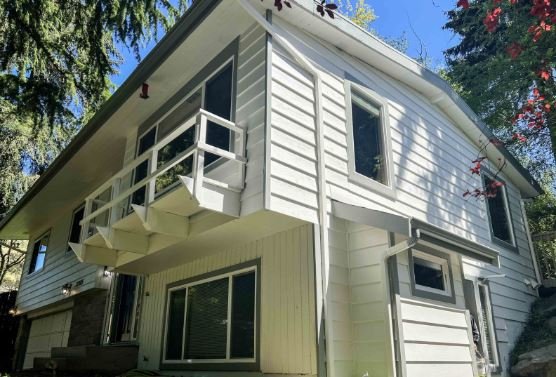
Cedar siding is a Northwest favorite—rich color, natural rot resistance, and unmistakable charm. Yet the same Pacific rain that keeps Washington green can wreak havoc on unprotected cedar, leading to peeling paint, mildew growth, and premature decay. Choosing the right coating (and the right prep) makes the difference between a finish that lasts a decade and one that fails in two seasons. If you’re planning to protect your home with quality exterior painting, here’s what to know about the best paint systems for cedar in our famously wet climate.
Why Cedar Needs Specialized Protection
- Moisture Intrusion
Western Washington averages 35–90 inches of rainfall annually. When cedar absorbs water faster than it can release it, paint loses adhesion and bubbles off. - Tannin Bleed
Cedar’s natural oils can discolor lighter paints unless you block them with the right primer. - Mildew & Algae
Persistent dampness encourages surface growth that breaks down paint film and dulls color.
A long-lasting paint job must address all three issues—starting with thorough surface prep and ending with breathable, flexible topcoats.
Top Paint Systems for Cedar in a Wet Climate
| Coating System | Key Benefits | Ideal Use | Expected Lifespan* |
| 100 % Acrylic Latex Paint (plus stain-blocking primer) | Breathable, excellent UV stability, resists cracking | Siding older than 3–5 years | 8–12 years |
| Solid-Color Acrylic Stain | Penetrates wood, less film build (fewer peels) | New or rough-sawn cedar | 6–10 years |
| Hybrid Alkyd-Acrylic Primer + Acrylic Topcoat | Superior tannin blocking and flexibility | High-exposure gables, fascia | 10–12 years |
| Elastomeric Coating | High film build, bridges hairline cracks | End-grain trim, checking boards | 12–15 years (if prepped well) |
*Assumes proper prep, two finish coats, and favorable application weather.
1. 100 % Acrylic Latex
A premium acrylic latex designed for coastal or high-humidity regions stays flexible in fluctuating temperatures, resists chalking, and lets cedar breathe. Pair it with a high-quality, alkyd-modified acrylic primer labeled “tannin blocking” to prevent discoloration.
2. Solid-Color Acrylic Stain
Unlike paint, solid stains soak into cedar, reducing surface tension. They won’t flake like thick paint films but will fade over time; expect to recoat every 6–8 years on high sun-exposure walls.
3. Hybrid Alkyd-Acrylic System
Using an oil-rich primer followed by acrylic topcoats combines strong adhesion with flexible UV resistance—a solid formula for boards likely to cup or crack.
4. Elastomeric Coating
On vertical grain cedar that has minor checking, elastomeric formulas move with the wood, sealing micro-gaps where moisture sneaks in. Because they’re thick, professional spray-and-back-roll application is crucial.
Surface Prep: The Make-or-Break Step
- Clean Thoroughly – Soft-wash with a low-pressure solution of detergent and mildewcide.
- Dry to < 15 % Moisture – Painting damp cedar traps water; use a moisture meter to confirm.
- Sand & Feather – Remove loose paint, smooth edges, and open grain for better penetration.
- Prime ASAP – Apply primer the same day you prep to prevent flash moisture.
Sheen & Color Considerations
- Satin or Low-Lustre finishes shed rain better than flat paints yet hide surface imperfections.
- Mid-tone Colors (earth browns, forest greens) outlast dark charcoal or deep reds, which absorb more heat and accelerate film aging.
Maintenance Schedule
- Annual Inspection – Check south- and west-facing walls for early chalking, mildew, or open joints.
- Spot Washing – A gentle hose rinse plus mild soap keeps algae at bay.
- Timely Touch-Ups – Address peeling edges promptly to stop moisture infiltration.
Installation Timing
Plan your exterior project for a 48-hour dry window with temperatures between 50 °F and 80 °F. Even “rain-ready” paints need at least two hours before the next drizzle; always read manufacturer specs.
If balancing prep, weather, and optimal products feels overwhelming, consider partnering with trusted exterior painting services. Professionals have moisture meters, spray equipment, and region-specific knowledge to deliver a finish that stands up to Washington’s wettest winters and sunniest summers alike.
Final Takeaway
The best exterior paint for cedar siding in Washington combines a high-quality, tannin-blocking primer with breathable, flexible topcoats—applied over meticulously prepped, dry wood. Choose acrylic latex or solid-color stains for most walls; reserve elastomeric or hybrid systems for problem areas. By investing in the right products and diligent maintenance, you’ll keep your cedar siding looking fresh and protected for years, no matter how rainy the forecast.